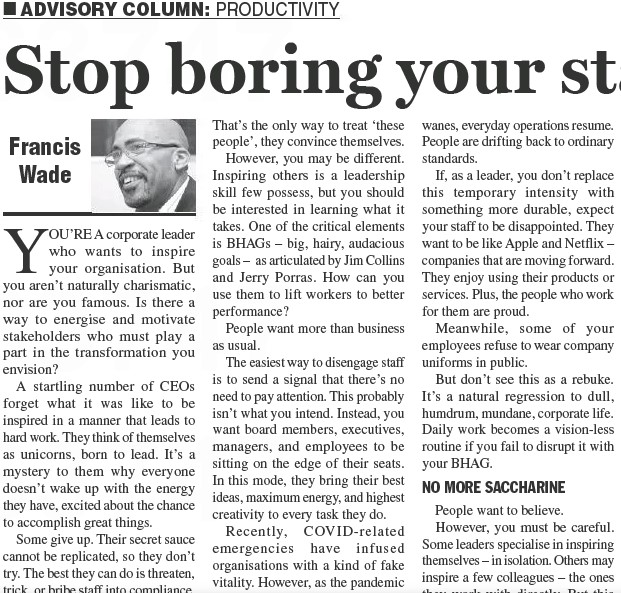You’re a corporate leader who wants to inspire your organization. But you aren’t naturally charismatic, nor are you famous. Is there a way to energize and motivate stakeholders who must play a part in the transformation you envision?
A startling number of CEOs forget what it was like to be inspired in a manner that leads to hard work. They think of themselves as unicorns, born to lead. It’s a mystery to them why everyone doesn’t wake up with the energy they have, excited about the chance to accomplish great things.
Some give up. Their secret sauce cannot be replicated, so they don’t try. The best they can do is threaten, trick, or bribe staff into compliance. That’s “the only way to treat these people”, they convince themselves.
However, you may be different. Inspiring others is a leadership skill few possess, but you should be interested in learning what it takes. One of the critical elements is BHAGs (Big Hairy Audacious Goals), as articulated by Jim Collins and Jerry Porras. How can you use them to lift workers to better performance?
- People Want More Than Business as Usual
The easiest way to disengage staff is to send a signal that “there’s no need to pay attention.” This probably isn’t what you intend. Instead, you want board members, executives, managers, and employees to be sitting on their edge of their seats. In this mode, they bring their best ideas, maximum energy, and highest creativity to every task they do.
Recently, COVID-related emergencies have infused organizations with a kind of fake vitality. However, as the pandemic wanes, everyday operations resume. People are drifting back to ordinary standards.
If, as a leader, you don’t replace this temporary intensity with something more durable, expect your staff to be disappointed. They want to be like Apple and Netflix – companies which are moving forward. They enjoy using their products or services. Plus, the people who work for them are proud.
Meanwhile, some of your employees refuse to wear company uniforms in public.
But don’t see this as a rebuke. It’s a natural regression to dull, humdrum, mundane, corporate life. Daily work becomes a vision-less routine if you fail to disrupt it with your BHAG.
- People Want to Believe
However, you must be careful. Some leaders specialize in inspiring themselves…in isolation. Others may inspire a few colleagues – the ones they work with directly. But this should be an organization-wide game.
To communicate, lazy executive teams try to get by with traditional vision and mission statements. Unfortunately, times have changed. The usual saccharine bromides no longer work – they are just too vague. If your statements can be swapped with that of another organization without anyone noticing, consider them to be stale.
Instead, you need far more details to make your plan credible and worthy of an emotional investment. Skeptical staff need to see metrics and milestones stretched out over several years. They want a concrete bridge between today and the final outcome. Something they can trust. After all, their future careers are on the line. Why should they bet on your company? And your vision?
- People Want to Act Now
Ever had a conversation with a child who wants to become a surgeon? They are probably two decades or more away from realizing their dream.
But one benefit of their public commitment is that there are clear and immediate expectations. For example, wherever they are on their journey, academic excellence is required. “Are you studying hard right now?” This clarity orients the child towards daily priorities and choices.
Contrast this with the corporate world, where the opposite tends to happen. A CEO announces a BHAG. Then employees go back to whatever they were doing before, safely knowing that it’s the path of least resistance.
The fact is, no-one translates the vision into everyday action. Between retreats, the BHAG flops.
The solution? Craft game-changing projects. Then, enlist sponsors and participants who understand their importance and believe in taking action.
They’ll probably need to set aside other projects and delay competing commitments. But this is exactly what you want. If this is important, other efforts must cease so that you can focus people’s attention.
Fail to do this and you’ll be dismayed to see people going through routines which should have been eliminated. They’ll waste time on email messages and meetings simply because of inertia. You’ll fail to make progress as people sit on the sidelines…bored…waiting for something interesting to happen.
Instead, gather your leaders together and lead from the front, with BHAGs which inspire everyone. You’ll tap into discretionary effort which has remained dormant and assure a sustainable future for your organization.

